Martinndungu1986
On this page, you find all documents, package deals, and flashcards offered by seller martinndungu1986.
- 630
- 0
- 20
Community
- Followers
- Following
650 items
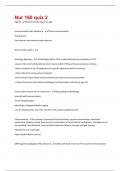
Nur 160 quiz Questions with Answers
Ageism - Discrimination based on age communication with aphasia pt - Direct communication Use gestures Use pictures and communication devices Diet for older adults - discharge planning - -should begin when client is admitted (with the exception of LTC) -assess if the client will be able to return home and/or if they will need assistance at home -assess residence to see if adaptations or specific equipment will be necessary -make referral to social worker if needed -communicate client h...
- Exam (elaborations)
- • 2 pages •
Ageism - Discrimination based on age communication with aphasia pt - Direct communication Use gestures Use pictures and communication devices Diet for older adults - discharge planning - -should begin when client is admitted (with the exception of LTC) -assess if the client will be able to return home and/or if they will need assistance at home -assess residence to see if adaptations or specific equipment will be necessary -make referral to social worker if needed -communicate client h...
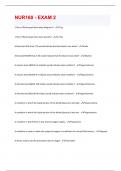
NUR160 - EXAM 2 questions with answers
1 liter of fluid equals how many kilograms? - 1 kg 1 liter of fluid equals how many pounds? - 2.2 lbs A blood pH LESS than 7.35 would indicate that the blood is too what? - Acidic A blood pH MORE than 7.45 would indicate that the blood is too what? - Alkaline A calcium level ABOVE 5.6 mEq/dL would indicate what condition? - Hypercalcemia A calcium level BELOW 4.5 mEq/dL would indicate what condition? - Hypocalcemia A chloride level ABOVE 106 mEq/L would indicate what condition? - Hyperchlo...
- Exam (elaborations)
- • 24 pages •
1 liter of fluid equals how many kilograms? - 1 kg 1 liter of fluid equals how many pounds? - 2.2 lbs A blood pH LESS than 7.35 would indicate that the blood is too what? - Acidic A blood pH MORE than 7.45 would indicate that the blood is too what? - Alkaline A calcium level ABOVE 5.6 mEq/dL would indicate what condition? - Hypercalcemia A calcium level BELOW 4.5 mEq/dL would indicate what condition? - Hypocalcemia A chloride level ABOVE 106 mEq/L would indicate what condition? - Hyperchlo...

CCBC Nursing 160: Exam and Answers
34. Which of the following chronic complications is associated with diabetes? a. Dizziness, dyspnea on exertion, and coronary artery disease. b. Retinopathy, neuropathy, and coronary artery disease. c. Leg ulcers, cerebral ischemic events, and pulmonary infarcts. d. Fatigue, nausea, vomiting, muscle weakness, and cardiac arrhythmia's. - *b. Retinopathy, neuropathy, and coronary artery disease.* These are all chronic complications of diabetes. A nurse shoud recognize which symptom as a ca...
- Exam (elaborations)
- • 68 pages •
34. Which of the following chronic complications is associated with diabetes? a. Dizziness, dyspnea on exertion, and coronary artery disease. b. Retinopathy, neuropathy, and coronary artery disease. c. Leg ulcers, cerebral ischemic events, and pulmonary infarcts. d. Fatigue, nausea, vomiting, muscle weakness, and cardiac arrhythmia's. - *b. Retinopathy, neuropathy, and coronary artery disease.* These are all chronic complications of diabetes. A nurse shoud recognize which symptom as a ca...
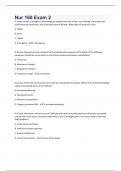
NUR 160 Exam and correct Answers
A 3 year old boy is brought to the emergency department with stridor, nasal flaring, intercostal and supraclavicular retractions, and respiratory rate of 40 bpm. What type of situation is this? A. Stable B. Acute C. Urgent D. Emergency - D. Emergency A 45 year old man has been admitted to the hospital with suspicion of PE. Which of the following symptoms should the nurse report to the primary health practitioner immediately? A. Chest pain B. Shortness of breath C. Respirations 20 bpm ...
- Exam (elaborations)
- • 7 pages •
A 3 year old boy is brought to the emergency department with stridor, nasal flaring, intercostal and supraclavicular retractions, and respiratory rate of 40 bpm. What type of situation is this? A. Stable B. Acute C. Urgent D. Emergency - D. Emergency A 45 year old man has been admitted to the hospital with suspicion of PE. Which of the following symptoms should the nurse report to the primary health practitioner immediately? A. Chest pain B. Shortness of breath C. Respirations 20 bpm ...
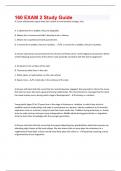
NUR 160 EXAM 2 Study Guide questions and answers
A 2-year-old becomes upset when her routine or environment changes, this; A. is abdominal for a toddler, they are adaptable. B. Means she is insecure and didn't develop trust in infancy. C. Means she is spoiled and needs punishment. D. Is normal for a toddler, they are ritualistic. - D. Is normal for a toddler, they are ritualistic. A 23-year-old woman has presented to the clinician to follow up her recent diagnosis of psoriasis. Which of the following assessments of the client's nails w...
- Exam (elaborations)
- • 43 pages •
A 2-year-old becomes upset when her routine or environment changes, this; A. is abdominal for a toddler, they are adaptable. B. Means she is insecure and didn't develop trust in infancy. C. Means she is spoiled and needs punishment. D. Is normal for a toddler, they are ritualistic. - D. Is normal for a toddler, they are ritualistic. A 23-year-old woman has presented to the clinician to follow up her recent diagnosis of psoriasis. Which of the following assessments of the client's nails w...
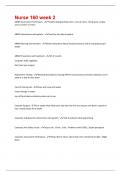
Nurse 160 week 2 Questions with Answers
AMRD Assessment Techniques - Trouble distinguishing colors , loss of vision , blind spots ,empty area in center of vision ARMD interactions with patient - stand to the side of patient ARMD Nursing Interventions - Patient education About Desiease process and its not going to get better ARMD Prevention and treatment - Vit C E and A eat green leafy vegitibles And Laser eye surgery Audometric Testing - Wearing head phones having diffrent sound waves and tones played to see if patient is abl...
- Exam (elaborations)
- • 6 pages •
AMRD Assessment Techniques - Trouble distinguishing colors , loss of vision , blind spots ,empty area in center of vision ARMD interactions with patient - stand to the side of patient ARMD Nursing Interventions - Patient education About Desiease process and its not going to get better ARMD Prevention and treatment - Vit C E and A eat green leafy vegitibles And Laser eye surgery Audometric Testing - Wearing head phones having diffrent sound waves and tones played to see if patient is abl...
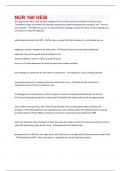
NUR 160 HESI QUESTIONS WITH CORRECT ANSWERS
A young woman who is the primary caregiver for her mother who has alzheimer's disease states "Sometimes I hate my mother for living this long and my Dad for dying and not caring for her." How do you respond. - "What do you do to cope with these feelings" (invites the client to share feelings and perceptions is most therapeutic) advancing oral intake from NPO - ice chips or water first then advance to a clear liquid and up. applying a condom catheter to an older male - shave the perinea...
- Exam (elaborations)
- • 2 pages •
A young woman who is the primary caregiver for her mother who has alzheimer's disease states "Sometimes I hate my mother for living this long and my Dad for dying and not caring for her." How do you respond. - "What do you do to cope with these feelings" (invites the client to share feelings and perceptions is most therapeutic) advancing oral intake from NPO - ice chips or water first then advance to a clear liquid and up. applying a condom catheter to an older male - shave the perinea...
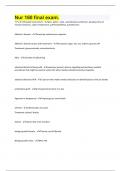
nur 160 final exam Questions and Answers
7 P's of orthopedic assessment - pain, pallor = pale , paresthesia( numbness) , paralysis( loss of muscle functions) , polar temperature, puffiness(edema), pulselessness Addison's disease - Caused by autoimmune response Addison's disease causes and treatments - decreased: sugar, salt, sex, sodium, glucose, BP Treatment: glucocorticoids, mineralcorticols ADLs - activities of daily living advanced directive (living will) - expresses person's desires regarding extraordinary medical proce...
- Exam (elaborations)
- • 18 pages •
7 P's of orthopedic assessment - pain, pallor = pale , paresthesia( numbness) , paralysis( loss of muscle functions) , polar temperature, puffiness(edema), pulselessness Addison's disease - Caused by autoimmune response Addison's disease causes and treatments - decreased: sugar, salt, sex, sodium, glucose, BP Treatment: glucocorticoids, mineralcorticols ADLs - activities of daily living advanced directive (living will) - expresses person's desires regarding extraordinary medical proce...
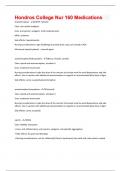
Hondros College Nur 160 Medications Questions and Answers
Acetaminophen - (APAP, Tylenol) Class: non-opioid analgesic Uses: anti-pyretic, analgesic, mild-moderate pain MOA: unknown Side effects: hepatotoxicity Nursing considerations: 4gm (4,000mg) max daily dose, may use instead of ASA Mucomyst (acetylcysteine) - reversal agent acetaminophen/hydrocodone - (Narco, Vicodin, Lortab) Class: opioid and acetaminophen, schedule II Uses: moderate-severe pain Nursing considerations: helps the dose of the narcotic to be kept small to avoid dependence a...
- Exam (elaborations)
- • 4 pages •
Acetaminophen - (APAP, Tylenol) Class: non-opioid analgesic Uses: anti-pyretic, analgesic, mild-moderate pain MOA: unknown Side effects: hepatotoxicity Nursing considerations: 4gm (4,000mg) max daily dose, may use instead of ASA Mucomyst (acetylcysteine) - reversal agent acetaminophen/hydrocodone - (Narco, Vicodin, Lortab) Class: opioid and acetaminophen, schedule II Uses: moderate-severe pain Nursing considerations: helps the dose of the narcotic to be kept small to avoid dependence a...
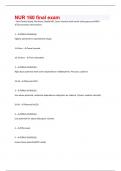
NUR 160 final questions and answers
Semi-Fowler's(low), flex knees, Notify MD, Cover intestine with sterile saline gauze and NPO - evisceration interventions 1 - DRUG SCHEDULE: highest potential for abuse(street drugs) 1-6 liters - nasal cannula 10-15 liters - non-rebreather 2 - DRUG SCHEDULE: High abuse potential with severe dependence risk(Morphine, Percocet, codeine) 22-26 - Normal HCO3 3 - DRUG SCHEDULE: Less abuse potential, moderate dependence risk(aspirin w/ codeine, Tylenol, anabolic steroids) 35-45 - Normal Pa...
- Exam (elaborations)
- • 21 pages •
Semi-Fowler's(low), flex knees, Notify MD, Cover intestine with sterile saline gauze and NPO - evisceration interventions 1 - DRUG SCHEDULE: highest potential for abuse(street drugs) 1-6 liters - nasal cannula 10-15 liters - non-rebreather 2 - DRUG SCHEDULE: High abuse potential with severe dependence risk(Morphine, Percocet, codeine) 22-26 - Normal HCO3 3 - DRUG SCHEDULE: Less abuse potential, moderate dependence risk(aspirin w/ codeine, Tylenol, anabolic steroids) 35-45 - Normal Pa...
